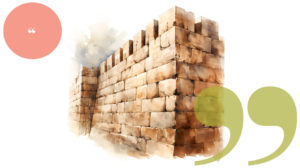Dreams Come True
| May 24, 2010I said to myself, oh, no — I can't write a book

I sent Pooh Bear invitations to ten friends. The invitations read:
Come To My Birthday Party
When: 13 Tammuz, Tuesday night!
Where: Sam Bagel’s
Why: ’Cause it’s my fortieth, and I want to share it with friends.
On the big day we all sat at a long table outdoors, under a tent at Sam’s. Me, at the head. I looked around at my special friends, and I thought about how quickly time has passed — and, baruch Hashem, how much we’ve accomplished.
Dina sat to my right. I remember when she told me she’d signed up for a sewing course, about ten years ago. She was learning to hem and make cuffs. Today Dina designs wedding gowns from scratch. She’s got a room in her home that’s all hers, with a large worktable and two sewing machines — and a photo album chockful of gowns that she designed, created, and sent on their way.
My friend Penina adapted a method for helping students with auditory processing disorders. For eight years she’s been developing, expanding, and improving on her method. She’s become a teacher of teachers.
Aliza, whose watercolors once dwelled safely inside a manila envelope, now submits her work to newspapers and children’s book publishers.
Sima, who began a N’shei comprising twenty women, now runs one comprising two hundred.
I watched my friends chatting and enjoying their Bagel Deluxe, and I savored the thought: Working toward one’s goals brings success. Not immediately, and often only after great effort, persistence, and prayer. But if a person is willing to work that hard, then he will succeed, in at least some measure, great or small.
Thirteen years ago I read about something I’ll call the “Dare to Dream” exercise, and decided to try it. This simple little exercise enabled me to see my goals, instead of just to think about them. It clarified what was meaningful to me, and what wasn’t. Mostly, it helped me to begin.
Dare to Dream Exercise
1.Take fifty pieces of 3x3 inch paper and write on each piece of paper one goal or dream — or just something you’d like to do. (Open home business, learn hilchos Shabbos, have weekly family meetings, exercise daily, paint the living room, counsel privately, sing back-up on music disk, get cleaning lady…) Don’t think too much, just write whatever comes to mind as quickly as you can.
2. Divide your fifty papers into three piles:
- (15 dreams)
- (20 dreams)
- Way Later. (15 dreams)
As you see, only 15 dreams may be placed in the “Now” pile, meaning, dreams that you wish to accomplish now, in the present; 20 dreams are placed in the “Later” pile, meaning, dreams that you wish to accomplish sometime in the future; and 15 dreams for the “Way Later” pile, meaning, dreams that are reserved for the faraway future.
3.) Take pile number one, the Now pile, and choose five from that. These five are the most important to you at this time. These are the five that you may be working on already. You don’t want to leave this world without having accomplished those babies. Place these five in a new file: “Top Priority.”
Now you have four piles, and your life plan. Begin! To reach any goal in the world, break down the process into manageable steps. Some dreams require a few steps, and some require a few hundred, but there is no goal so lofty or complex that cannot be broken down and simplified. And if ever the very first step seems insurmountable, break down the step a little more.
Several years ago I found this in my Top Priority pile: Write book. I said to myself: Oh, no — I can’t write a book. And it was true, I can’t write a book. But I could write a page, and sometimes two. So that’s what I did. On the first day I wrote a page. On the second day I wrote a page. For the next five years I wrote or edited one page until I’d written a book called Copycat.
I keep my dreams in a beautiful flower-textured envelope where I can take them out easily. When one dream is realized, I replace it with the next one on the list. I remove, replace, re-dream as often as I like, going at my own pace — no matter how slow that pace may be.
There’s nothing to it, but to do it.
Leah Subar is the writer and composer of Uncle Reuven and the Simcha Train, the number one best-selling children’s music series (Country Yossi Magazine, 2005.) Her young adult novel, titled Copycat, will soon be released by Targum Press.
(Originally featured in Family First, Issue 108)
Oops! We could not locate your form.













